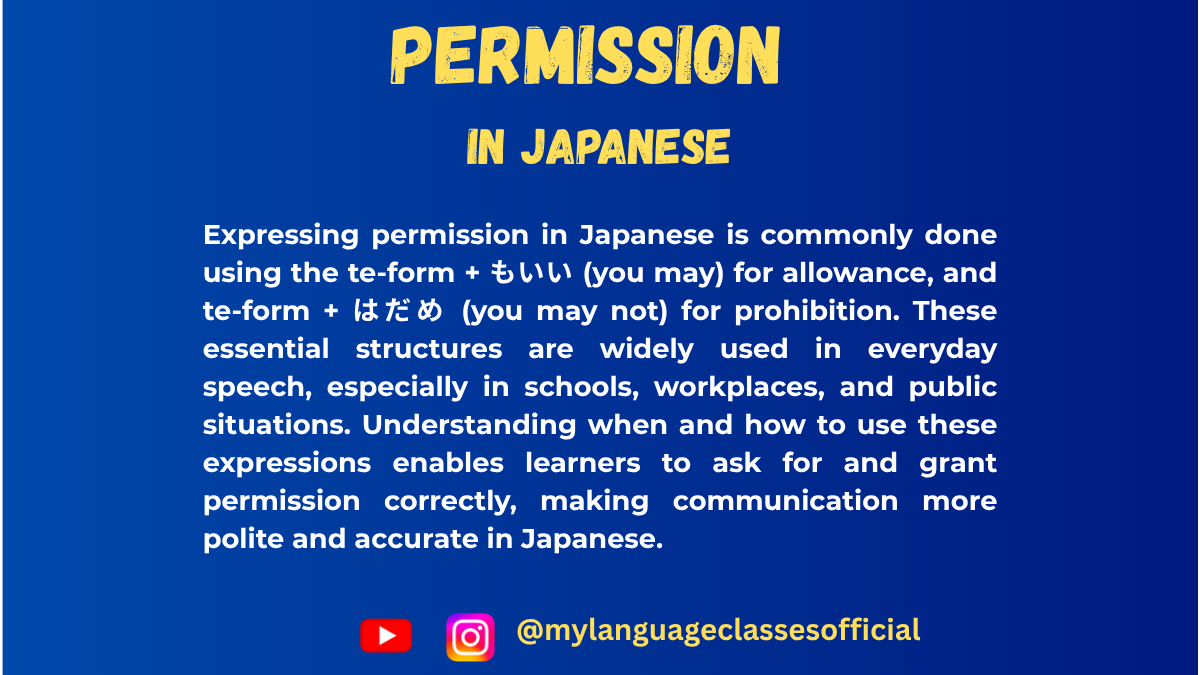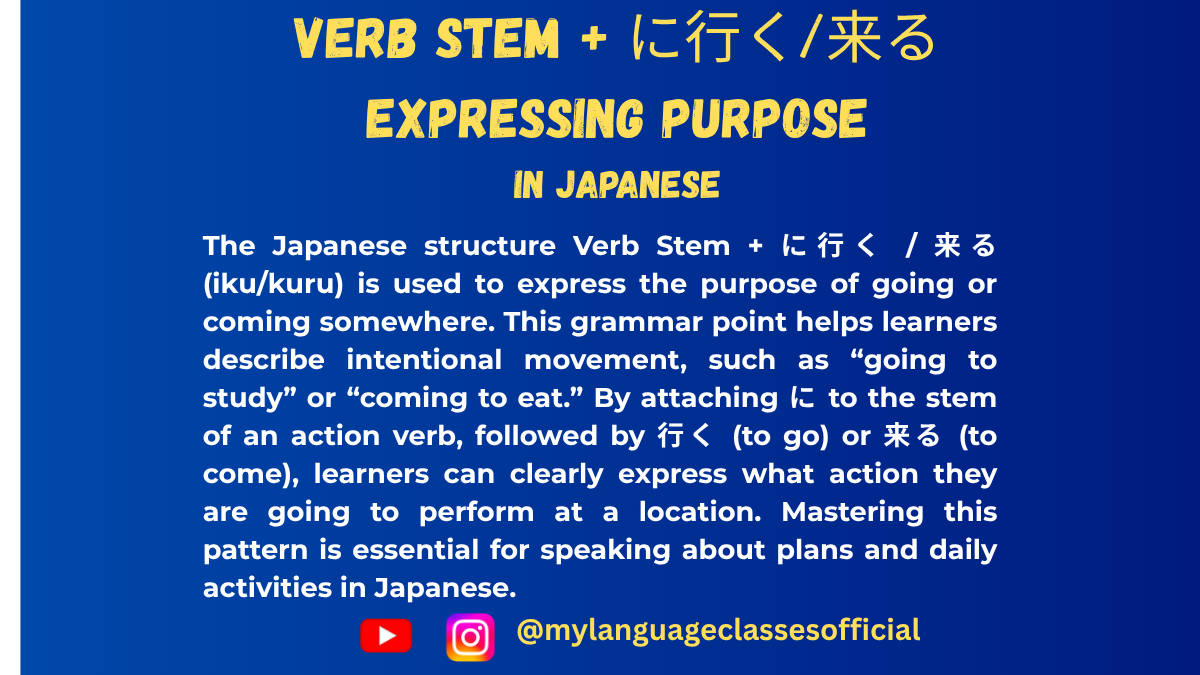Your cart is currently empty!
Tag: language
-
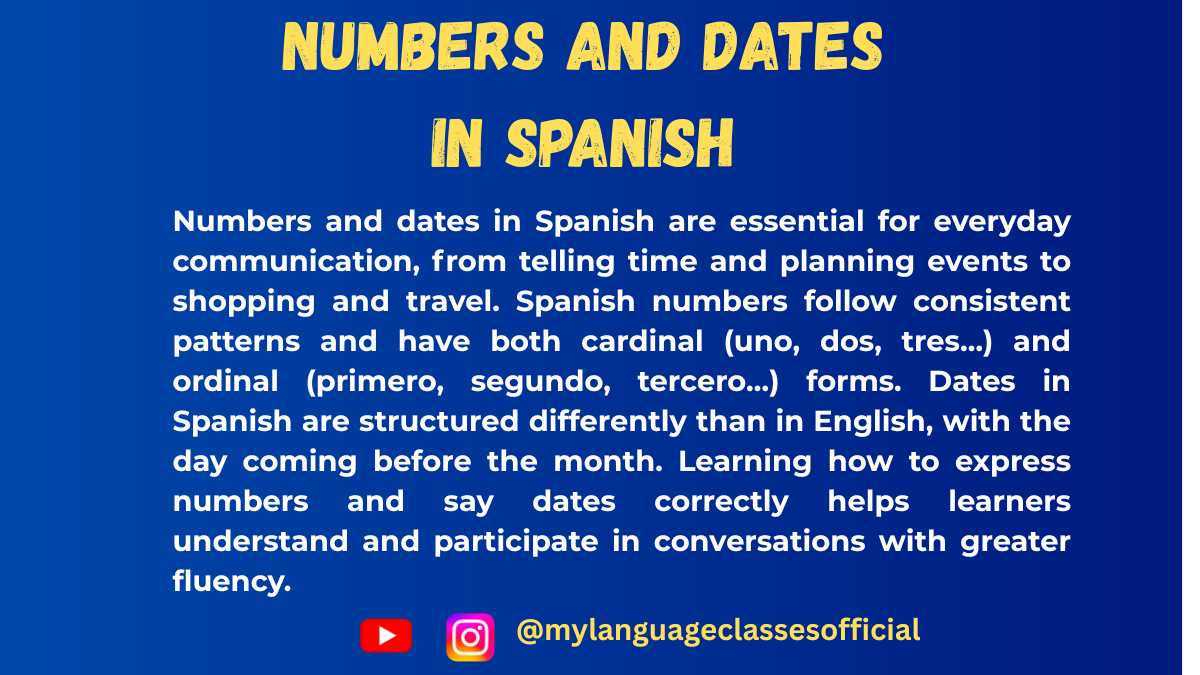
Spanish Numbers and Dates
Learning numbers and dates in Spanish is essential for mastering the language, as they are used daily for everything from making appointments to discussing history. In this blog post, we’ll explore the basics of Spanish numbers and dates, along with tips to practice and use them effectively.
Spanish Numbers: The Basics
Cardinal Numbers
Cardinal numbers (números cardinales) are the most basic form of numbers, used for counting. Here’s a quick overview of the key milestones:- 0-10: Cero, uno, dos, tres, cuatro, cinco, seis, siete, ocho, nueve, diez
- 11-19: Once, doce, trece, catorce, quince, dieciséis, diecisiete, dieciocho, diecinueve
- Tens (20-90): Veinte, treinta, cuarenta, cincuenta, sesenta, setenta, ochenta, noventa
- Hundreds and beyond: Cien (100), doscientos (200), mil (1,000), un millón (1,000,000)
Key Tips for Numbers:
- Pronunciation Practice: Numbers like “cinco” (five) and “siete” (seven) can trip up non-native speakers. Practice listening and repeating them to get the rhythm right.
- Connector for Numbers Over 30: Spanish uses “y” (and) to connect tens and units, e.g., treinta y cinco (35). However, numbers below 30 are written as a single word, like veintidós (22).
Dates in Spanish
Understanding how to talk about dates is vital for everyday conversations. The structure differs slightly from English, so let’s break it down.
The Format
In Spanish, the day comes before the month:
DD/MM/YYYY
For example: 15 de marzo de 2024 (March 15, 2024)Months of the Year
Enero (January), febrero (February), marzo (March), abril (April), mayo (May), junio (June), julio (July), agosto (August), septiembre (September), octubre (October), noviembre (November), diciembre (December)Days of the Week
Lunes (Monday), martes (Tuesday), miércoles (Wednesday), jueves (Thursday), viernes (Friday), sábado (Saturday), domingo (Sunday)Key Tips for Dates:
- Ordinal Numbers: Only use ordinal numbers (e.g., primero for “first”) for the first day of the month. For example, el primero de enero (January 1st). All other days use cardinal numbers: el dos de enero (January 2nd).
- Prepositions: Use de to indicate “of” when saying the full date: el 5 de mayo de 2023.
Practice Makes Perfect
To solidify your understanding of numbers and dates in Spanish, here are some fun activities to try:
- Practice with a Calendar: Choose a calendar in Spanish and try saying the dates aloud.
- Role-Playing Scenarios: Pretend to make appointments or book trips. For example, “¿Qué fecha es hoy?” (“What date is it today?”) or “Mi cumpleaños es el 10 de octubre” (“My birthday is October 10th”).
- Listening Practice: Watch Spanish-language videos or listen to podcasts where dates and numbers are mentioned. Pay close attention to how native speakers pronounce them.
Common Mistakes to Avoid
- Mixing Up Dates: Remember that “3/12/2024” in Spanish means December 3, 2024, not March 12.
- Mispronunciation of Compound Numbers: For example, veintidós (22) is often mispronounced because learners forget the stress on the final syllable.
Learning numbers and dates in Spanish is a rewarding step toward fluency. With consistent practice and attention to the nuances of pronunciation and structure, you’ll be able to confidently use these essential tools in your everyday Spanish conversations. ¡Buena suerte! (Good luck!)
What challenges have you faced with Spanish numbers and dates? Share your experiences in the comments below!
If you enjoyed this lesson, be sure to check out more posts like this on my blog at My Language Classes. Don’t forget to subscribe my YouTube channel and follow me on Instagram for the latest language learning tips and lessons. Leave a comment below to share your thoughts, or ask any questions you have.
Happy learning! 😊
-
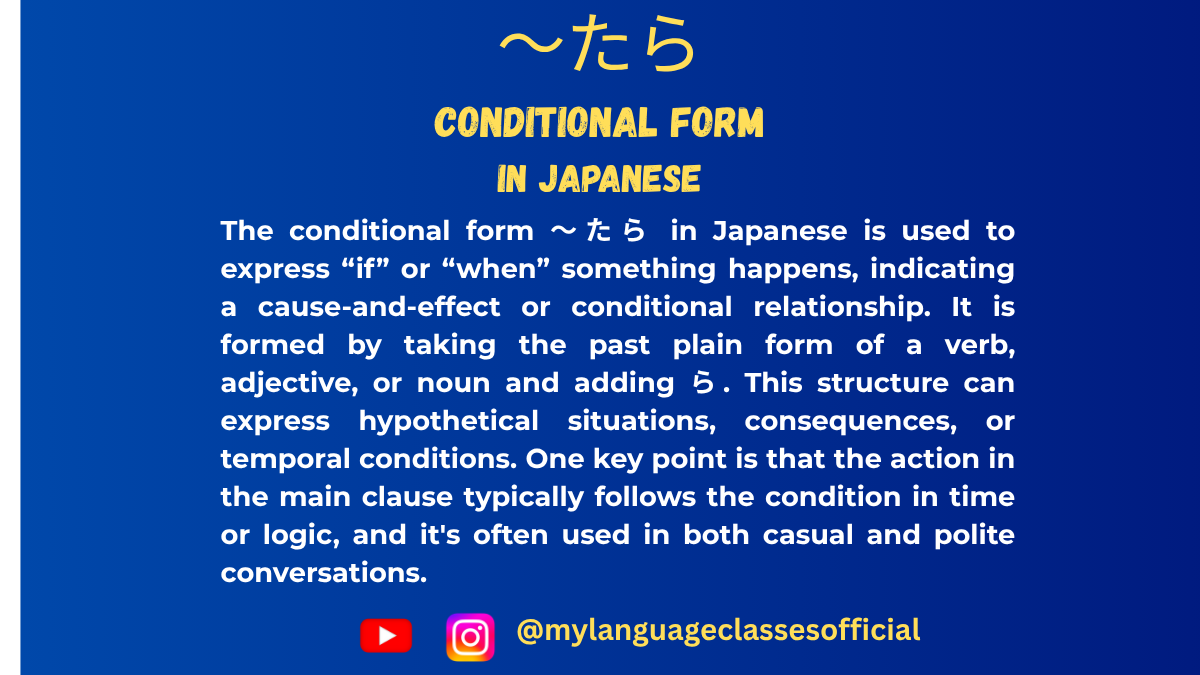
Understanding Conditional form ~たら in Japanese | My Language Classes
Understanding ~たら in Japanese
Learning Japanese grammar often feels like solving a puzzle, where each piece contributes to your fluency. One such critical piece is the ~たら structure, a conditional form that translates roughly to “if” or “when” in English. In this blog post, we’ll break down how to use ~たら effectively, covering its structure, usage, and nuances, along with examples to boost your confidence.
What is ~たら?
The ~たら structure comes from the past tense form of a verb, adjective, or noun, combined with ら (ra). It’s used to express conditional situations, which means it helps us talk about “if” or “when” something happens.
Key Functions of ~たら:
- Expressing Conditions: “If X happens, then Y will occur.”
- Temporal Sense: “When X happens, Y will follow.”
This dual meaning is a hallmark of ~たら, and context determines whether it means “if” or “when.”
The Structure of ~たら
Let’s look at how to form ~たら for different word types:
1. Verbs
- Take the plain past tense form (た-form) of the verb + ら.
- Example:
食べる → 食べた → 食べたら (if/when [I] eat)
2. Adjectives
- For い-adjectives, replace the final い with かったら.
- Example: 高い → 高かった → 高かったら (if/when [it’s] expensive)
- For な-adjectives, use the structure: adjective + だったら.
- Example: 静か → 静かだったら (if/when [it’s] quiet)
3. Nouns
- Combine the noun with だったら.
- Example: 休み → 休みだったら (if/when [it’s] a holiday)
Usage Examples
Let’s explore ~たら in action, both as “if” and “when.”
1. Conditional “If”
- 日本に行ったら、寿司を食べたいです。
(Nihon ni ittara, sushi o tabetai desu.)
If I go to Japan, I want to eat sushi. - 時間があったら、映画を見ましょう。
(Jikan ga attara, eiga o mimashou.)
If we have time, let’s watch a movie.
Here, the meaning hinges on a hypothetical condition being met.
2. Temporal “When”
- 家に帰ったら、宿題をします。
(Ie ni kaettara, shukudai o shimasu.)
When I get home, I’ll do my homework. - 雨がやんだら、公園で遊びましょう。
(Ame ga yandara, kouen de asobimashou.)
When the rain stops, let’s play at the park.
In these examples, ~たら conveys a temporal relationship, emphasizing a sequence of events.
Nuances and Tips
- Avoid Overlapping ~たら with ~と or ~ば
While ~と and ~ば also express conditions, ~たら is more versatile because it handles both “if” and “when.” However, ~と is more deterministic (e.g., water boils when heated), and ~ば can feel more formal or speculative. - Expressing Surprise or Discovery
~たら is also used to convey unexpected results:- ドアを開けたら、猫がいました。
(Doa o aketara, neko ga imashita.)
When I opened the door, there was a cat.
Here, the speaker did not anticipate finding a cat.
- ドアを開けたら、猫がいました。
- Avoid Using ~たら for Certainties
If an event is guaranteed to occur (e.g., the sun rising), use a temporal marker like ~時 instead of ~たら.
Practice Time!
Try making your own sentences using ~たら. Here are some prompts to get you started:
- What would you do if you won the lottery?
宝くじに当たったら、______。 - What will you do when the weekend comes?
週末になったら、______。
Share your answers in the comments or with your language partner. Practice makes perfect!
Final Thoughts
The ~たら structure is a cornerstone of Japanese conditional grammar. By mastering it, you’ll unlock the ability to express complex ideas about possibilities and sequences. Remember to pay attention to context to distinguish between “if” and “when,” and don’t hesitate to experiment with it in your conversations.
Ready to elevate your Japanese skills? Try using ~たら today!
If you enjoyed this lesson, be sure to check out more posts like this on my blog at My Language Classes. Don’t forget to subscribe my YouTube channel and follow me on Instagram for the latest language learning tips and lessons. Leave a comment below to share your thoughts, or ask any questions you have about nouns.
Happy learning! 😊
-
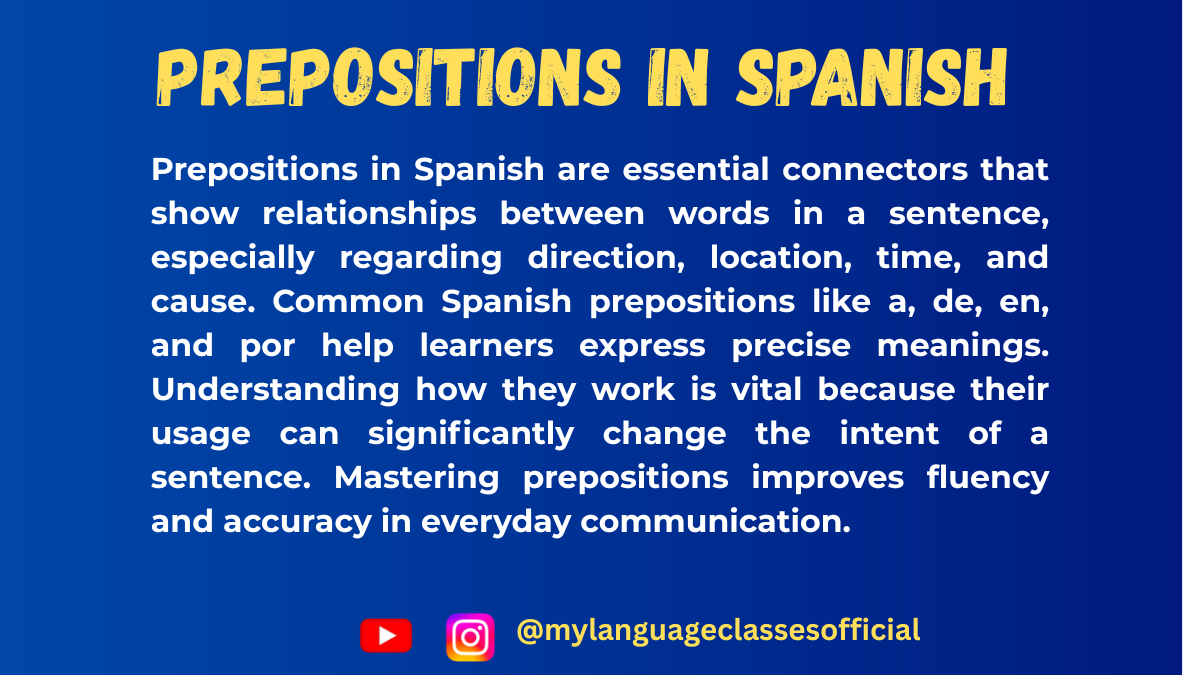
Mastering Prepositions in Spanish
Learning Spanish prepositions can seem tricky at first, but they’re essential for mastering the language. Prepositions are words that establish relationships between elements in a sentence, such as place, time, or cause. In this post, we’ll explore prepositions of place, prepositions of time, and other key types of prepositions in Spanish, with practical examples to enhance your understanding.
1. Prepositions of Place (Preposiciones de lugar)
Prepositions of place indicate the location of an object or person in relation to another. These are some of the most common:
Preposition Meaning Example en in/on/at El libro está en la mesa. (The book is on the table.) sobre on/above La lámpara está sobre la cama. (The lamp is above the bed.) bajo under/below El gato está bajo la silla. (The cat is under the chair.) entre between/among La tienda está entre el banco y la farmacia. (The store is between the bank and the pharmacy.) al lado de next to Mi casa está al lado de la escuela. (My house is next to the school.) frente a in front of El coche está frente a la casa. (The car is in front of the house.) Common Pitfall:
Learners often confuse en (in/on/at) with a (to/at). Remember:
- En emphasizes location (Estoy en casa = “I am at home”).
- A indicates motion or direction (Voy a casa = “I’m going home”).
2. Prepositions of Time (Preposiciones de tiempo)
Prepositions of time indicate when something happens. Here are key examples:
Preposition Meaning Example a at Nos vemos a las cinco. (We’ll see each other at five.) en in/on Nací en marzo. (I was born in March.) desde since/from Trabajo aquí desde 2018. (I’ve worked here since 2018.) hasta until Estaré aquí hasta las tres. (I’ll be here until three.) durante during Fuimos a España durante las vacaciones. (We went to Spain during the holidays.) Note:
The prepositions a and en often cause confusion when talking about time. For instance:
- Use a to refer to specific hours (a las siete = “at seven”).
- Use en for months, years, or periods (en abril = “in April”).
3. Other Common Prepositions
Beyond place and time, prepositions convey various relationships like cause, manner, or possession.
Preposition Meaning Example de of/from/about La casa de Juan es grande. (Juan’s house is big.) por for/because of/by Gracias por tu ayuda. (Thank you for your help.) para for/to/in order to Este regalo es para ti. (This gift is for you.) con with Voy al cine con mis amigos. (I’m going to the movies with my friends.) sin without No salgas sin paraguas. (Don’t go out without an umbrella.) Por vs. Para:
- Por often indicates a reason or means (Lo hice por amor = “I did it out of love”).
- Para suggests purpose or destination (Lo hice para ti = “I did it for you”).
4. How to Master Spanish Prepositions
- Practice with Context: Prepositions often don’t translate directly, so practice them within phrases.
- Memorize with Mnemonics: Use memory aids for tricky pairs like por and para.
- Engage in Real-Life Usage: Try journaling, speaking, or chatting with native speakers to reinforce prepositional phrases.
- Use Visual Aids: Draw diagrams to represent relationships like location (sobre = above, bajo = below).
Conclusion
Understanding and using prepositions correctly is a vital step in becoming fluent in Spanish. While their nuances may seem challenging, consistent practice and exposure will make them second nature. Whether you’re talking about the book on the table (sobre la mesa) or planning a meeting at five (a las cinco), prepositions allow you to express complex ideas with precision.
What are your biggest challenges with Spanish prepositions? Share your experiences in the comments! Let’s learn together. 😊
If you enjoyed this lesson, be sure to check out more posts like this on my blog at My Language Classes. Don’t forget to subscribe my YouTube channel and follow me on Instagram for the latest language learning tips and lessons. Leave a comment below to share your thoughts, or ask any questions you have.
Happy learning! 😊
-
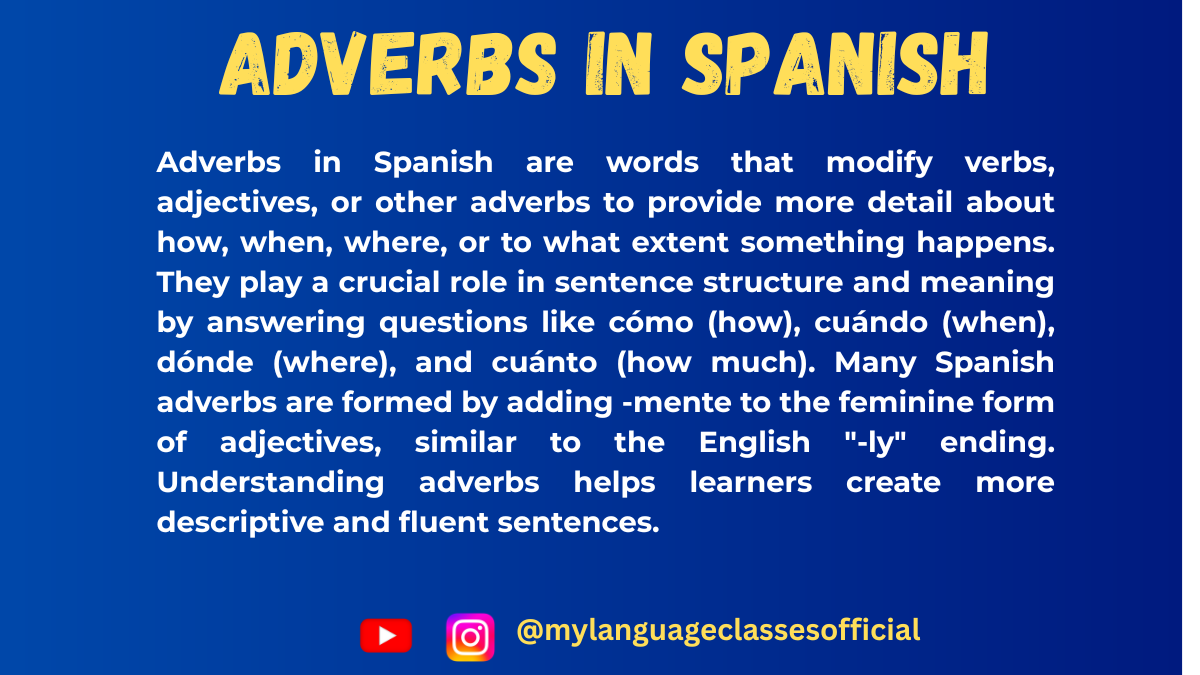
Exploring Spanish Adverbs
Adverbs are essential in Spanish, providing important details about actions—when, where, and how often they happen. Mastering adverbs will help you express yourself more clearly and accurately in everyday conversations. In this blog post, we’ll break down three important types of adverbs: adverbs of frequency, adverbs of time, and adverbs of place. Each type has its own role in enriching your sentences.
1. Adverbs of Frequency: How Often?
Adverbs of frequency tell us how often an action takes place. They are essential for describing habits, routines, and general tendencies in our daily lives. Common adverbs of frequency in Spanish include words like siempre (always) and nunca (never), which are often used to express regularity or lack thereof.
For example:
- Siempre (Always): Yo siempre tomo café por la mañana.
(I always drink coffee in the morning.) - Nunca (Never): Nunca llego tarde al trabajo.
(I never arrive late to work.)
Here’s a table summarizing common adverbs of frequency, their English meanings, and example sentences:
Adverbs of Frequency
Adverb (Spanish) English Meaning Example Sentence (Spanish) Translation (English) Siempre Always Yo siempre tomo café por la mañana. I always drink coffee in the morning. A menudo Often Ellos visitan a sus abuelos a menudo. They often visit their grandparents. Frecuentemente Frequently Los niños frecuentemente juegan en el parque. The children frequently play in the park. A veces Sometimes A veces leo libros en la biblioteca. Sometimes I read books in the library. Rara vez Rarely Ella rara vez come comida rápida. She rarely eats fast food. Nunca Never Nunca llego tarde al trabajo. I never arrive late to work. Tip: In Spanish, adverbs of frequency like siempre and nunca typically come before the verb, while others like a veces and frecuentemente can vary in position for emphasis.
2. Adverbs of Time: When?
Adverbs of time tell us when an action happens. They help us frame the timeline of a conversation, allowing us to specify moments in time—whether something happens right now, in the past, or in the future.
For example:
- Ahora (Now): Estoy estudiando ahora. (I am studying now.)
- Mañana (Tomorrow): Mañana tengo una reunión importante. (Tomorrow I have an important meeting.)
Here’s a table with some common adverbs of time and examples:
Adverbs of Time
Adverb (Spanish) English Meaning Example Sentence (Spanish) Translation (English) Ahora Now Estoy estudiando ahora. I am studying now. Hoy Today Hoy vamos al cine. Today we are going to the cinema. Mañana Tomorrow Mañana tengo una reunión importante. Tomorrow I have an important meeting. Ayer Yesterday Ayer cociné una paella deliciosa. Yesterday I cooked a delicious paella. Tarde Late Llego tarde a la clase de español. I am late for the Spanish class. Temprano Early Siempre llegamos temprano al aeropuerto. We always arrive early at the airport. Tip: When using adverbs of time, be sure to place them where they make the most sense contextually—before or after the verb depending on what you want to emphasize.
3. Adverbs of Place: Where?
Adverbs of place answer the question “Where?” These adverbs describe the location of an action. They are especially helpful in giving directions or providing specific details about where something happens. Common adverbs of place include aquí (here), allí (there), cerca (close), and lejos (far).
For example:
- Aquí (Here): Ven aquí, por favor. (Come here, please.)
- Lejos (Far): Su oficina está lejos de la estación de tren. (Their office is far from the train station.)
Here’s a table summarizing common adverbs of place:
Adverbs of Place
Adverb (Spanish) English Meaning Example Sentence (Spanish) Translation (English) Aquí Here Ven aquí, por favor. Come here, please. Allí There Dejé mis llaves allí. I left my keys there. Cerca Close/Nearby Hay un supermercado cerca de mi casa. There’s a supermarket near my house. Lejos Far Su oficina está lejos de la estación de tren. Their office is far from the train station. Dentro Inside El gato está dentro de la caja. The cat is inside the box. Fuera Outside Los niños juegan fuera. The children play outside. Tip: Adverbs of place often go after the verb, but they can sometimes appear at the beginning of the sentence for emphasis.
Final Thoughts
Adverbs are powerful tools in Spanish that help add context to your sentences. By using adverbs of frequency, adverbs of time, and adverbs of place, you can make your speech or writing much more expressive. Practice using them in different contexts, and soon they will become a natural part of your Spanish communication.
¡Buena suerte en tu aprendizaje! (Good luck with your learning!)
If you enjoyed this lesson, be sure to check out more posts like this on my blog at My Language Classes. Don’t forget to subscribe my YouTube channel and follow me on Instagram for the latest language learning tips and lessons. Leave a comment below to share your thoughts, or ask any questions you have.
Happy learning! 😊
- Siempre (Always): Yo siempre tomo café por la mañana.
-

Understanding ある vs いる Japanese Existence Verbs | My Language Classes
Japanese Existence Verbs: ある (Aru) vs いる (Iru)
In Japanese, one of the fundamental concepts is the idea of existence, or being. Just like in any language, expressing whether something exists or is present is crucial to communication. In Japanese, this is expressed using two key verbs: ある (aru) and いる (iru).
Though both words translate as “to be” or “to exist,” their usage depends on the type of subject you’re referring to. This difference can be tricky for learners, but once you grasp it, you’ll find yourself speaking more naturally in Japanese.
1. ある (Aru) — Used for Inanimate Objects or Abstract Concepts
The verb ある (aru) is used to express the existence of inanimate objects, things, places, or abstract concepts. If the subject is something that doesn’t have life (like a chair, book, or idea), ある is the correct verb to use.
Examples:
- 本がある。
(Hon ga aru)
“There is a book.” - 学校がある。
(Gakkou ga aru)
“There is a school.”
(Literally, “A school exists.”) - 問題がある。
(Mondai ga aru)
“There is a problem.”
(Literally, “A problem exists.”)
As you can see, ある applies to non-living things—whether they are physical objects, places, or even abstract ideas like problems or opportunities.
2. いる (Iru) — Used for Living Things
On the other hand, いる (iru) is used to indicate the existence of living things, such as people, animals, or any other beings that can move or have consciousness. This includes everything from pets to people to animals.
Examples:
- 犬がいる。
(Inu ga iru)
“There is a dog.”
(Literally, “A dog exists.”) - 先生がいる。
(Sensei ga iru)
“There is a teacher.”
(Literally, “A teacher exists.”) - 友達がいる。
(Tomodachi ga iru)
“I have friends.”
(Literally, “Friends exist.”)
The verb いる is also commonly used to refer to living things when you’re describing their existence in a particular place or context. It’s important to note that いる is for beings that can move, think, or live.
The Difference Between ある and いる
To put it simply:
- Use ある when talking about inanimate objects, things, or places.
- Use いる when talking about living things—people, animals, etc.
How to Make Sentences Negative: ない (Nai)
Just like with other verbs in Japanese, you can make sentences negative by adding ない (nai), which is the negative form of both ある and いる.
- ある becomes ない:
本がない。 (Hon ga nai) — “There is no book.” - いる becomes いない:
犬がいない。 (Inu ga inai) — “There is no dog.”
These negative forms are essential for talking about the absence of something or someone.
Other Uses of ある and いる
- Existence in the Past (だった / いた) Just like in English, we can also talk about past existence in Japanese. あった (atta) and いた (ita) are the past tense forms of ある and いる, respectively.
- 本があった。
(Hon ga atta)
“There was a book.” - 犬がいた。
(Inu ga ita)
“There was a dog.”
- 本があった。
- Describing Location Both ある and いる are also used when talking about the location of things or people. The particles に (ni) or で (de) are typically used to indicate where the subject exists.
- 机の上に本がある。
(Tsukue no ue ni hon ga aru)
“There is a book on the desk.” - 公園に犬がいる。
(Kouen ni inu ga iru)
“There is a dog in the park.”
- 机の上に本がある。
A Helpful Trick to Remember
A simple trick to remember the difference between ある and いる is to think of the phrase “Life is moving.”
- いる for living things = I for I (living being, me, you, animals).
- ある for inanimate things = A for A object.
This small mnemonic can help keep the two verbs straight as you practice!
Conclusion
Understanding ある (aru) and いる (iru) is an essential part of learning Japanese, as it helps you express existence in various contexts. Whether you’re talking about inanimate objects, people, animals, or abstract concepts, knowing when to use each verb will make your Japanese sound more fluent and natural.
If you’re new to learning Japanese, start practicing these verbs with simple sentences and gradually increase complexity. With a little practice, expressing existence will become second nature to you!
If you enjoyed this lesson, be sure to check out more posts like this on my blog at My Language Classes. Don’t forget to subscribe my YouTube channel and follow me on Instagram for the latest language learning tips and lessons. Leave a comment below to share your thoughts, or ask any questions you have about nouns.
Happy learning! 😊
- 本がある。
-
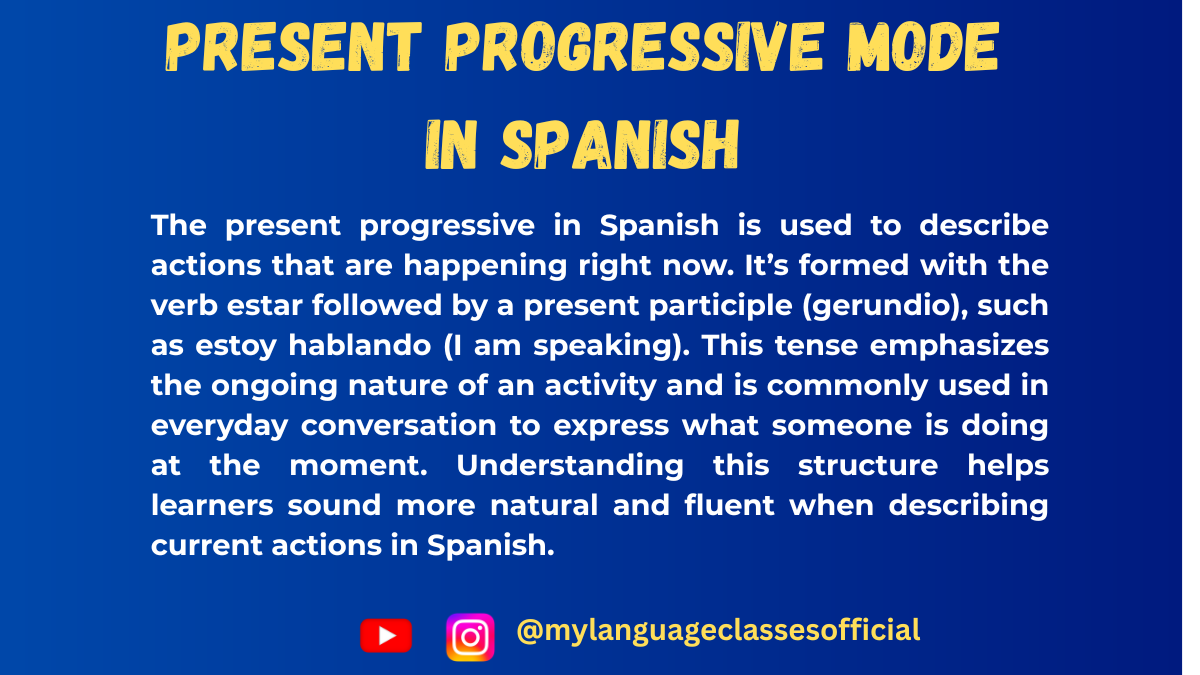
Mastering Present Progressive in Spanish
The present progressive tense (or continuous tense) is one of the most practical and dynamic structures in Spanish. It’s the equivalent of the English “present continuous” tense and is used to describe actions happening right now. If you’ve ever said something like “I am studying” in English, you’ve used a structure similar to Spanish: “Estoy estudiando.”
In this guide, you’ll learn what the present progressive is, how to form it correctly, when to use it, common irregularities, and common mistakes to avoid. Let’s dive in!
What is the Present Progressive?
The present progressive is used to describe actions that are happening right now. It combines the verb estar (to be) as an auxiliary with another verb in its gerund form.
For example:
- Estoy escribiendo (I am writing).
- Estamos aprendiendo español (We are learning Spanish).
How to Form the Present Progressive
1. Conjugate the Verb “Estar”
First, conjugate estar in the present tense according to the subject. Here’s a quick review:
Subject Conjugation of “Estar” Yo estoy Tú estás Él/Ella/Usted está Nosotros/as estamos Vosotros/as estáis Ellos/Ellas/Ustedes están 2. Add the Gerund Form of the Main Verb
The gerund (or present participle) is formed by adding -ando to the stem of -ar verbs and -iendo to the stem of -er and -ir verbs.
Verb Type Example Verb Gerund Form Example -AR Hablar Hablando Estoy hablando (I am speaking). -ER Comer Comiendo Estás comiendo (You are eating). -IR Vivir Viviendo Ellos están viviendo (They are living).
Irregularities in Present Progressive Formation
While most verbs follow the standard -ando/-iendo pattern, some verbs have irregular gerund forms. These can be categorized based on their unique characteristics:
1. Verbs with Spelling Changes
Some verbs change spelling in the gerund to maintain proper pronunciation or avoid awkward letter combinations.
Verb Gerund Form Example Leer Leyendo Estoy leyendo (I am reading). Construir Construyendo Están construyendo (They are building). Oír Oyendo Está oyendo (He/She is hearing). Caer Cayendo Estoy cayendo (I am falling).
2. Stem-Changing Verbs in -IR
Stem-changing verbs that end in -ir modify their stem vowel in the gerund form. These changes occur in verbs that have e → i or o → u shifts in the present tense.
Verb Gerund Form Example Dormir Durmiendo Estoy durmiendo (I am sleeping). Morir Muriendo Está muriendo (He/She is dying). Servir Sirviendo Están sirviendo (They are serving). Pedir Pidiendo Estoy pidiendo (I am requesting).
3. Irregular Verbs with Unique Forms
Certain highly irregular verbs have gerunds that do not follow standard rules.
Verb Gerund Form Example Ir Yendo Estoy yendo (I am going). Poder Pudiendo Está pudiendo (He/She is able to). Venir Viniendo Estamos viniendo (We are coming).
When to Use the Present Progressive
Use the present progressive when describing actions that are happening right now or in the immediate present. Examples include:
- ¿Qué estás haciendo? (What are you doing?)
- Estoy estudiando para un examen. (I am studying for a test.)
- Estamos trabajando en un proyecto. (We are working on a project.)
Common Mistakes to Avoid
- Overusing the Present Progressive In Spanish, the simple present tense is often used instead of the present progressive for habitual actions or near-future events. For example:
- English: I am going to the store tomorrow.
- Correct Spanish: Voy a la tienda mañana. (Not Estoy yendo a la tienda mañana.)
- Incorrect Gerund Formation Remember the spelling and stem changes discussed above. For example:
- Incorrect: Están leiendo.
- Correct: Están leyendo.
- Forgetting to Conjugate “Estar” Always ensure that estar matches the subject of the sentence. For example:
- Incorrect: Ellos está comiendo.
- Correct: Ellos están comiendo.
Practice Exercises
Try these sentences and check your understanding:
- I am listening to music. → (Translate to Spanish)
- We are running in the park. → (Translate to Spanish)
- What are you writing? → (Translate to Spanish)
Conclusion
The present progressive is an essential tool for Spanish learners, especially when you want to describe ongoing actions. By mastering estar + gerundio and learning how to handle irregular verbs, you’ll speak Spanish with greater fluency and confidence. Practice regularly, and don’t be afraid to make mistakes—they are part of the learning process!
¿Qué estás esperando? (What are you waiting for?) Start using the present progressive in your Spanish conversations today!
-
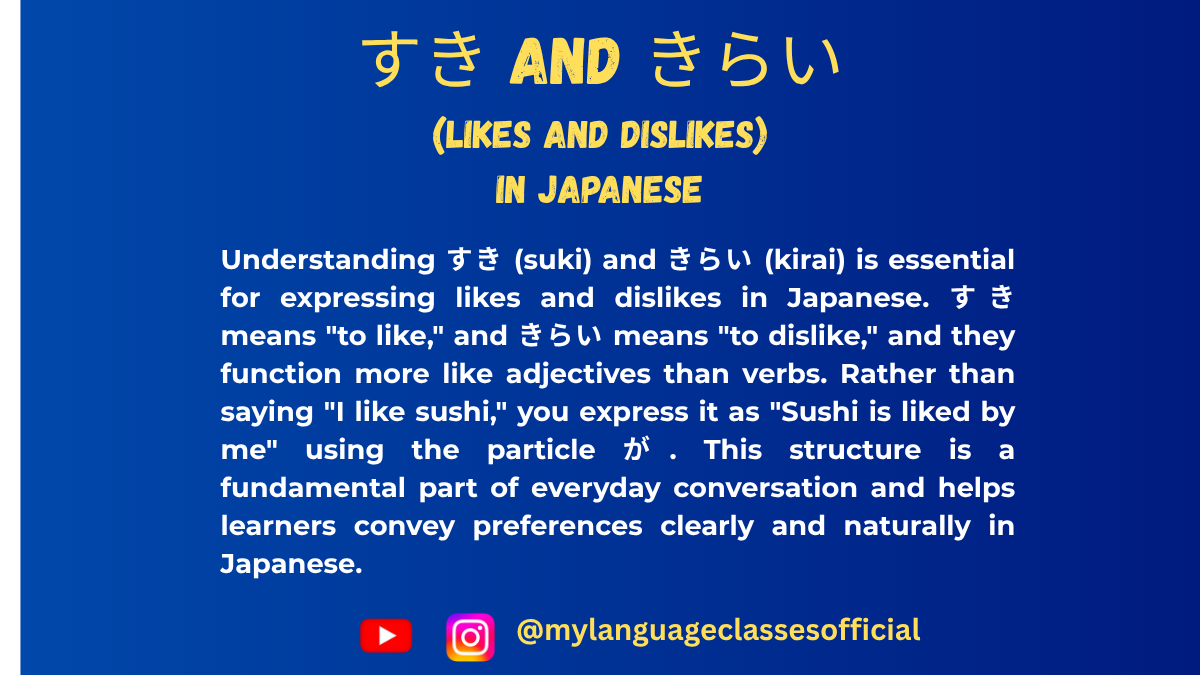
Expressing Likes and Dislikes すき and きらい in Japanese | My Language Classes
Likes and Dislikes in Japanese
こんにちは!(Konnichiwa!)
Learning how to express preferences is one of the most useful and fun parts of mastering Japanese. Today, let’s dive into two essential words: 好き (すき) for “like” and 嫌い (きらい) for “dislike.” Not only will we explore their meanings, but also how to use them naturally in sentences.
1. 好き (すき) – To Like
How to Use 好き
The word 好き means “like” or “fond of” and is commonly used to express your preferences. The structure is simple:
Noun + が好き
This translates to “I like [noun].”Examples:
- 日本語が好きです。
Nihongo ga suki desu.
I like Japanese.- Here, 日本語 (Nihongo) means “Japanese,” and が marks it as the topic you like. Adding です makes it polite.
- 犬が好き。
Inu ga suki.
I like dogs.- This informal version is common among friends or in casual settings.
Expressing Love or Passionate Likes
To emphasize your love or deep passion for something, you can use 大好き (だいすき/daisuki):
- チョコレートが大好きです!
Chokorēto ga daisuki desu!
I love chocolate!
2. 嫌い (きらい) – To Dislike
How to Use 嫌い
On the flip side, 嫌い means “dislike” or “hate.” The structure is the same as 好き:
Noun + が嫌い
This means “I dislike [noun].”Examples:
- ピザが嫌いです。
Piza ga kirai desu.
I dislike pizza.- ピザ (Piza) means “pizza.” While it’s a popular dish, some people might find it too greasy!
- 虫が嫌い。
Mushi ga kirai.
I hate insects.- 虫 (Mushi) refers to “insects.” Use this informal structure with friends.
Expressing Strong Dislike
If you strongly dislike something, you can say 大嫌い (だいきらい/daikirai):
- 雨が大嫌いです!
Ame ga daikirai desu!
I hate rain!
3. Cultural Notes
- “Softer Tone for Dislikes”: In Japanese culture, direct expressions of dislike like 嫌い might come off as too strong in some situations. To soften it, you can use phrases like:
- あまり好きじゃない (Amari suki janai) – “I don’t really like [it].”
- ちょっと苦手です (Chotto nigate desu) – “I’m a bit bad with [it].”
- Overuse of 好き: While 好き is positive, saying it too often might sound insincere. Balance your expressions to match the context.
4. Grammar and Nuance Tips
- No Verb Needed:
Both 好き and 嫌い function as な-adjectives, not verbs. This means they don’t need any conjugation or additional verbs to form basic sentences.Example:- Correct: 猫が好きです。 (Neko ga suki desu. – “I like cats.”)
- Incorrect: 猫が好きをです。 (Neko ga suki wo desu. – This is ungrammatical.)
- が (Ga) vs. は (Wa):
Although が is standard for these structures, は can be used for contrast or emphasis:- 犬は好きですが、猫は嫌いです。
Inu wa suki desu ga, neko wa kirai desu.
I like dogs, but I dislike cats.
- 犬は好きですが、猫は嫌いです。
5. Practice Time!
Let’s put what you’ve learned into action. Try completing these sentences:
- 私は ______ が好きです。
(Watashi wa ______ ga suki desu.)- Translate: “I like ______.”
- 友達は ______ が嫌いです。
(Tomodachi wa ______ ga kirai desu.)- Translate: “My friend dislikes ______.”
- ______ は大好きです!
(______ wa daisuki desu!)- Translate: “I love ______!”
6. Wrap-Up
Now you can confidently express what you like and dislike in Japanese! Start practicing by talking about your favorite foods, hobbies, and activities. Try to notice how native speakers use 好き and 嫌い in conversations—it will deepen your understanding.
If you have questions or want to share your sentences, feel free to leave a comment below!
それでは、またね!(Soredewa, matane!)If you enjoyed this lesson, be sure to check out more posts like this on my blog at My Language Classes. Don’t forget to subscribe my YouTube channel and follow me on Instagram for the latest language learning tips and lessons. Leave a comment below to share your thoughts, or ask any questions you have about nouns.
Happy learning! 😊
- 日本語が好きです。
-
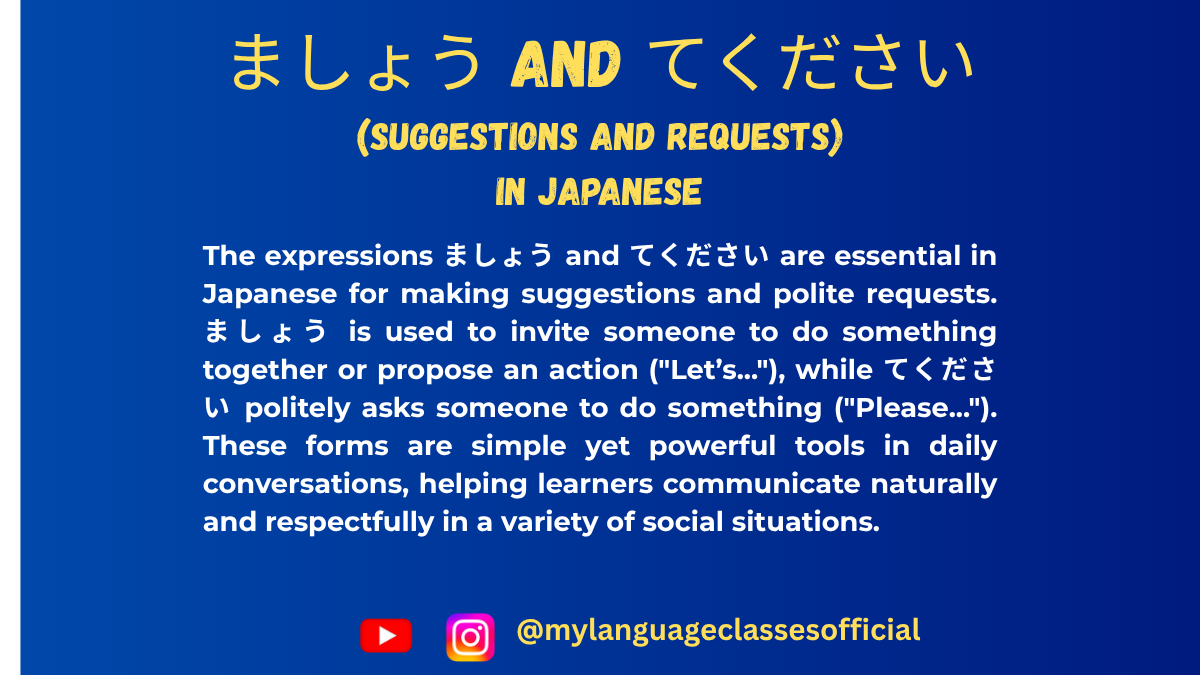
Making Suggestions and Polite Requests ましょう and てください in Japanese | My Language Classes
Mastering Polite Suggestions and Requests in Japanese
If you’re learning Japanese, understanding how to make polite suggestions and requests is a key part of effective communication. Whether you’re planning activities with friends or politely asking for help, two common expressions—Verb stem + ましょう and Verb stem + てください—are your go-to tools. Let’s dive into their usage, including how to form them step by step.
1. Making Suggestions with ましょう (mashou): “Let’s [verb]”
The expression ましょう is a polite and versatile way to suggest an activity or propose an idea. It carries a collaborative tone, meaning “Let’s do [verb].”
How to Form the ましょう Form
Japanese verbs are divided into three groups, and the method for creating the ましょう form depends on the group.
Group 1: U-Verbs (Godan Verbs)
- Start with the stem of the verb (remove the u-ending).
- Replace the u sound with the i sound.
- Add ましょう.
Verb Stem Change to i Form Add ましょう Example Translation 行く 行 行き 行きましょう Let’s go. 書く 書 書き 書きましょう Let’s write. 話す 話 話し 話しましょう Let’s talk.
Group 2: Ru-Verbs (Ichidan Verbs)
- Remove the final る.
- Add ましょう.
Verb Stem Add ましょう Example Translation 食べる 食べ 食べましょう Let’s eat. 見る 見 見ましょう Let’s look.
Group 3: Irregular Verbs
There are two irregular verbs, and their ましょう forms are as follows:
Verb Change to Stem Add ましょう Example Translation する し しましょう Let’s do it. 来る (kuru) 来 (ki) 来ましょう Let’s come.
When to Use ましょう
- Planning with others:
Example: 公園へ行きましょう!(Kōen e ikimashou!) = Let’s go to the park! - Encouraging teamwork:
Example: 一緒に勉強しましょう。(Issho ni benkyou shimashou.) = Let’s study together.
The tone is polite, making it suitable for formal and casual settings, as long as it’s a group-oriented activity.
2. Making Requests with てください (tekudasai): “Please [verb]”
Before diving into てください, we need to understand how to form the te-form of verbs. The te-form is one of the most fundamental conjugations in Japanese grammar and is used in various contexts beyond requests, such as making commands, linking actions, and creating the polite request structure てください.
How to Make the Te-Form
Japanese verbs are categorized into three groups, and the rules for forming the te-form differ depending on the group.
Group 1: U-Verbs (Godan Verbs)
For verbs ending in う, つ, る, む, ぶ, ぬ, く, ぐ, す, follow these rules:
- Replace the final u-sound with its corresponding te-form sound:
Ending Te-Form Rule Example う Replace with って 買う (kau) → 買って (katte) = Buy つ Replace with って 立つ (tatsu) → 立って (tatte) = Stand る Replace with って 取る (toru) → 取って (totte) = Take む Replace with んで 読む (yomu) → 読んで (yonde) = Read ぶ Replace with んで 遊ぶ (asobu) → 遊んで (asonde) = Play ぬ Replace with んで 死ぬ (shinu) → 死んで (shinde) = Die く Replace with いて 書く (kaku) → 書いて (kaite) = Write ぐ Replace with いで 泳ぐ (oyogu) → 泳いで (oyoide) = Swim す Replace with して 話す (hanasu) → 話して (hanashite) = Speak
Group 2: Ru-Verbs (Ichidan Verbs)
For verbs ending in る, simply drop る and add て:
- 食べる (taberu) → 食べて (tabete) = Eat.
- 見る (miru) → 見て (mite) = Look.
Group 3: Irregular Verbs
There are only two irregular verbs in Japanese:
- する → して = Do.
Example: 勉強する (benkyou suru) → 勉強して (benkyou shite) = Study. - 来る (kuru) → 来て (kite) = Come.
Forming てください
Once you have the te-form of a verb, simply add ください to make a polite request:
- 見る (miru) → 見て (mite) + ください = 見てください (mite kudasai) = Please look.
- 書く (kaku) → 書いて (kaite) + ください = 書いてください (kaite kudasai) = Please write.
- 手伝う (tetsudau) → 手伝って (tetsudatte) + ください = 手伝ってください (tetsudatte kudasai) = Please help.
When to Use It
- Asking politely:
Example: ちょっと待ってください。(Chotto matte kudasai.) = Please wait a moment. - Giving instructions:
Example: ドアを閉めてください。(Doa o shimete kudasai.) = Please close the door.
This phrase is polite and commonly used in both formal and informal situations.
Key Differences Between ましょう and てください
Expression Purpose Tone Verb stem + ましょう Suggestion: “Let’s do [verb]” Collaborative and inclusive Verb stem + てください Request: “Please do [verb]” Respectful and polite
Quick Practice: Try It Out!
Let’s put these into practice. Can you guess the correct form for each scenario?
- You’re suggesting to a friend: “Let’s watch a movie.”
Hint: The verb is 見る (miru).
Answer: 映画を見ましょう!(Eiga o mimashou!) - You’re asking someone politely: “Please listen to me.”
Hint: The verb is 聞く (kiku).
Answer: 私の話を聞いてください。(Watashi no hanashi o kiite kudasai.)
Conclusion
Mastering ましょう and てください opens up a world of polite and smooth communication in Japanese. By understanding these structures—and learning how to form the te-form and ましょう—you can make suggestions, request actions, and navigate various social situations with confidence. Practice them in your daily conversations, and soon they’ll become second nature!
What are your favorite phrases using ましょう or てください? Share them in the comments below! Or, if you have any questions about Japanese grammar, feel free to ask. Let’s keep learning together—日本語を楽しみましょう!(Nihongo o tanoshimimashou!) 😊
If you enjoyed this lesson, be sure to check out more posts like this on my blog at My Language Classes. Don’t forget to subscribe my YouTube channel and follow me on Instagram for the latest language learning tips and lessons. Leave a comment below to share your thoughts, or ask any questions you have about nouns.
Happy learning! 😊

